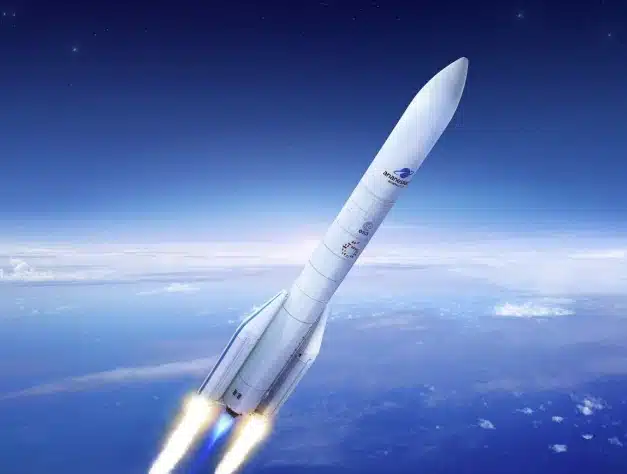Space
World Leader In Space Technology: Atomic Clocks, IMUs, GNSS Simulators, and Timing Solutions
Exploring space requires precise navigation and positioning technology. From GNSS simulators to ensure mission safety, to the atomic clocks orbiting the earth on board satellites, to hermetically sealed inertial measurement units integrated into launch vehicles, Safran is committed to mission success.
Mitigating GNSS Risk In Space Missions
Space vehicles are highly dependent on GNSS signals during their launch and also when traveling in orbit. Because they are so reliant on these signals, they become extremely vulnerable if something goes wrong – such as if they were to lose a connection with those signals or experience interference from jamming or spoofing.
Because of this, there is a critical need to: 1.) simulate how a GPS/GNSS receiver on board a space vehicle will react in order to identify vulnerabilities and ensure proper functionality during a real-world mission; and 2.) utilize precise inertial measurement units and time synchronization solutions to ensure the vehicles stay on their intended trajectory and can adapt if necessary.
The four main product lines that serve the space industry include:
Rubidium Atomic Clocks for Satellites
- Safran has deployed atomic clocks on board Galileo satellites for the most precise time keeping in the world. The Ground Active Hydrogen Maser is also relevant for space applications.
Inertial Measurement Units
- Safran’s tactical-grade inertial measurement units are hermetically sealed and are a good fit for satellite attitude and orbit control systems (AOCS) and launchers. Customer configurable outputs offer you operational flexibility.
GNSS Simulators
- The GNSS simulators can generate real RF signals and test how your GPS receivers will perform before the mission even starts. You can simulate 1000’s of scenarios and space flight trajectories.
Precision Timing Products
- To achieve precise telemetry for space missions Safran provides ultra-accurate timing devices that will synchronize both command and control centers and launch vehicles.
Safran vs. Standard Solutions: What Space Missions Really Need
| Feature | Standard GNSS Time Appliance | Safran Space Portfolio |
|---|---|---|
| Mission Simulation Support | Limited signal emulation; no multi-scenario | Skydel + GSG-8 GNSS Simulator for pre-launch validation, jamming/spoofing scenarios, and hardware-in-the-loop testing |
| On-Board Timing for Satellites | OCXO-based timing; drift in harsh conditions | RAFS Atomic Clocks onboard; space-qualified Rubidium oscillators with high radiation tolerance and nanosecond stability |
| In-Flight Navigation Integration | Not designed for inertial or sensor fusion | SpaceNaute IMU for launch-phase and satellite navigation; compact and radiation-hardened |
| GNSS Reception In Space | Limited (typically LEO only) | Skylight GNSS Receiver: dual-frequency, multi-constellation, space-hardened; supports GEO/MEO/LEO with spoofing resistance |
| Ground Control Time Sync | Basic NTP, limited holdover | SecureSync® 2400: multi-GNSS, IRIG-B, PTP, NTP, 1PPS; supports space shuttle–to–ground sync + GNSS-denied failover options (Rubidium/CSAC) |
| Traceability & Data Logging | Minimal logs; no UTC traceability | Full chain-of-trust: from UTC to simulator to onboard clock to telemetry timestamps |
| Regulatory / Program Compliance | non-radiation tested | Space-grade certifications (ESA, NASA heritage); MIL-STD, ECSS, and ITAR-compliant variants available |
| 24/7 Support for Mission Critical Ops | Typically limited to 3rd party vendor hours | 24/7 support with program-specific SLAs; global response capability for simulation, GNSS, or onboard failures |

Simulation for Devices with Embedded GNSS Receivers
When it’s time to test your GNSS equipment that will operate in space, a GNSS simulator can help. With Safran GNSS Simulation Software, you can:
- Simulate power level adjustments based on distances to other satellites in space;
- Model how the vehicle travels above the ionosphere;
- Create specific spaced trajectories – such as orbital and spacecraft maneuvering;
- Rely on high-update rates that reflect real-world scenarios of vehicles travelling at high speeds.
Trajectory Management for Launch Into Orbit & Space Exploration
For the critical moments during rocket launches as well as space maneuvering, inertial measurement units (IMUs) are the key tools that guide the space vehicle. Safran IMUs are optimized for low size, weight and power, are robust to withstand extreme shock vibrations and space radiations and have unlimited life durations. The SpaceNaute, for example, enables accurate navigation and guidance in all kinds of missions:
- Sun Synchronous Orbit (SSO)
- Geostationary Earth Orbit (GEO)
- Geostationary Transfer Orbit (GTO and GTO+)
- Deorbitation
- Deep Space Exploration


Pointing Sensors for Attitude & Orbit Control Systems (AOCS)
After a satellite is separated from a launch vehicle, it’s up to the Attitude and Orbit Control System (AOCS) to ensure that the satellite maintains the correct orientation and trajectory for its mission. To accomplish this, the AOCS needs accurate sensors magnetometers and gyroscopes to gather data on the satellite’s position and angle. Safran’s STIM377H can accomplish key angular measurement tasks without the aid of GPS. IMUs and gyroscope sensors on board satellites can help:
- Maintain attitude, ensuring the satellite points in the right direction (i.e. aligning solar panels with the sun, or antennas with ground stations);
- Controlling orbit, detecting movement from gravitational forces and other disturbances to keep the satellite in orbit;
- Maneuvering, knowing which direction to move to avoid collision.
Ultra-Compact Inertial Measurement Unit (IMU) for Space Launchers
SpaceNaute is the most advanced inertial measurement unit for space applications in the world. Selected and qualified for Ariane 6 European launcher, it offers excellent performance and very high reliability under harsh conditions.
SpaceNaute provides high performance inertial navigation capabilities thanks to:
- HRG Crystal™ cutting-edge technology for foolproof reliability
- Insensitive to space radiation and vibration
- Compact and low weight

Reliable Navigation Capabilities for Space Launches & Space Transportation
SpaceNaute offers the best of its generation, all criteria combined: SWaP, robustness, longevity, precision… Guaranteeing space launchers perfect control over their navigation and orientation in space, SpaceNaute covers all space applications, from put into orbit to space exploration.
Connect With Us
Contact us today to learn more about solutions for space applications.
